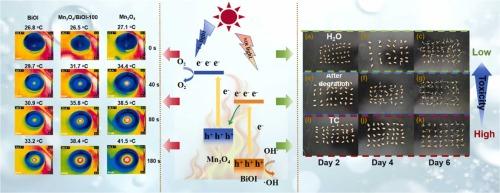Synergistic effect of photothermal-assisted photocatalysis and S-scheme heterojunction in Mn3O4/BiOI towards efficient pollutants degradation
IF 7.2
2区 工程技术
Q1 ENGINEERING, CHEMICAL
引用次数: 0
Abstract
Photocatalytic degradation of antibiotic and organic pollutants in wastewater constituted a pivotal strategy for achieving environmental sustainability. We fabricated a novel S-scheme Mn3O4/BiOI heterojunction, further in-depth investigating the photothermal-assisted photocatalytic activity for pollutants degradation. The optimized Mn3O4/BiOI-100 composite exhibited superior full-sunlight- induced catalytic activity for tetracycline degradation, demonstrating more 3.29-fold enhancements compared to pristine Mn3O4 and BiOI. This performance enhancement arose from the effects of efficient charge separation through the S-scheme mechanism and favorable photothermal catalyst surface. Notably, the composite maintained robust catalytic efficiency in complex aqueous matrices containing various ions. Biological validation through rice seed germination assays revealed complete elimination of phytotoxicity in treated pollutant solutions, realizing the value-added catalytic conversion from nocuous molecules. Radical trapping experiments identified •OH and •O2⁻ as primary reactive species, consistent with the proposed S-scheme mechanism subsequently verified by in situ XPS analysis. The photocatalytic degradation and COD removal abilities were also significantly enhanced for other six organic pollutants such as rhodamine B, congo red, methyl orange, methylene blue, p-chlorophenol, and phenol. This study provides a design blueprint for constructing photothermal-assisted S-scheme heterojunction photocatalysts for practical water purification applications.

光热辅助光催化与s型异质结在Mn3O4/BiOI中对污染物高效降解的协同作用
光催化降解废水中的抗生素和有机污染物是实现环境可持续性的关键策略。我们制备了一种新的S-scheme Mn3O4/BiOI异质结,进一步深入研究了光热辅助光催化降解污染物的活性。优化后的Mn3O4/BiOI-100复合材料对四环素的降解具有较好的催化活性,比原始的Mn3O4和BiOI提高了3.29倍。这种性能的增强是由于S-scheme机制有效的电荷分离和有利的光热催化剂表面的影响。值得注意的是,该复合材料在含有多种离子的复杂水性基质中保持了强大的催化效率。通过水稻种子萌发试验进行的生物学验证表明,处理后的污染物溶液完全消除了植物毒性,实现了有害分子的增值催化转化。自由基捕获实验确定•OH和•O2是主要的反应物质,与提出的S-scheme机制一致,随后被原位XPS分析证实。对罗丹明B、刚果红、甲基橙、亚甲基蓝、对氯酚和苯酚等6种有机污染物的光催化降解和COD去除能力也显著增强。本研究为构建光热辅助s型异质结光催化剂提供了设计思路。
本文章由计算机程序翻译,如有差异,请以英文原文为准。
求助全文
约1分钟内获得全文
求助全文
来源期刊

Journal of Environmental Chemical Engineering
Environmental Science-Pollution
CiteScore
11.40
自引率
6.50%
发文量
2017
审稿时长
27 days
期刊介绍:
The Journal of Environmental Chemical Engineering (JECE) serves as a platform for the dissemination of original and innovative research focusing on the advancement of environmentally-friendly, sustainable technologies. JECE emphasizes the transition towards a carbon-neutral circular economy and a self-sufficient bio-based economy. Topics covered include soil, water, wastewater, and air decontamination; pollution monitoring, prevention, and control; advanced analytics, sensors, impact and risk assessment methodologies in environmental chemical engineering; resource recovery (water, nutrients, materials, energy); industrial ecology; valorization of waste streams; waste management (including e-waste); climate-water-energy-food nexus; novel materials for environmental, chemical, and energy applications; sustainability and environmental safety; water digitalization, water data science, and machine learning; process integration and intensification; recent developments in green chemistry for synthesis, catalysis, and energy; and original research on contaminants of emerging concern, persistent chemicals, and priority substances, including microplastics, nanoplastics, nanomaterials, micropollutants, antimicrobial resistance genes, and emerging pathogens (viruses, bacteria, parasites) of environmental significance.
 求助内容:
求助内容: 应助结果提醒方式:
应助结果提醒方式:


